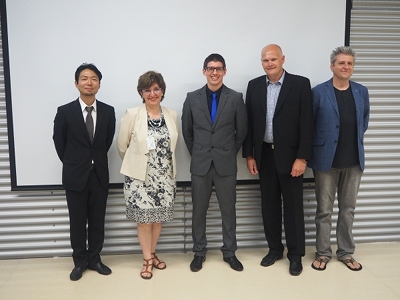Antonio Bazzo, PhD student under the supervision of Dr. Atsushi Urakawa has defended his PhD Thesis entitled “Continuous photocatalytic fuel production over wide-bandgap metal oxides” (assigned to the Department of Physical and Inorganic Chemistry of the Universitat Rovira i Virgili) publicly on July 23rd at the ICIQ auditorium.
The members of his evaluation committee were: Prof. José Ramón Galán-Mascarós (ICIQ), Prof. Magnus Rønning (Norwegian University of Science and Technology) and Prof. Deniz Üner (Middle East Technical University Ankara).
Abstract:
Artificial photosynthesis has been proposed as one of the possible solutions to the energetic and chemical-feedstock problems to cope with the anticipated near future depletion of fossil fuel resources. This doctoral thesis deals with the study of promising catalysts and reactor designs to enhance the reaction efficiency and understand the origin of photocatalytic activity. A continuous flow reaction system was designed and constructed to study CO2 photoreduction with H2O and photocatalytic water splitting. Photocatalytic activity of wide-bandgap semiconductor oxides such as TiO2, Ta2O5, MTaO3 (M = Na, K), and Ga2O3 was evaluated by using two different reactors, namely slurry and gas phase reactors. High pressure mercury lamps were used as the light source. Effects of co-catalysts (Pt and Rh-Cr) and dopants (Zn) on gas phase products evolution were investigated. From TiO2-based catalysts, H2 and CH4 were detected and quantified. The activity was mostly of a transient nature (deactivating). Importantly this work elucidated that the activity could be recovered in the dark (without irradiation) in the mixture of CO2 and H2O. The recovery process was more efficient at higher temperatures. In situ DRIFTS study gained mechanistic insights into the recovery process over Pt/TiO2. Ta and Ga oxides-based materials, co-modified with Zn and Rh-Cr, exhibited high overall steady-state water splitting activity, whereas no CO2 reduction activity was observed. Photophysic techniques were used to identify the key roles of Zn and Ru-Cr promotion in boosting catalytic activity and oxygen production.
